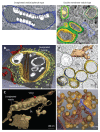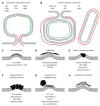Architecture and biogenesis of plus-strand RNA virus replication factories
- PMID: 24175228
- PMCID: PMC3785047
- DOI: 10.5501/wjv.v2.i2.32
Architecture and biogenesis of plus-strand RNA virus replication factories
Abstract
Plus-strand RNA virus replication occurs in tight association with cytoplasmic host cell membranes. Both, viral and cellular factors cooperatively generate distinct organelle-like structures, designated viral replication factories. This compartmentalization allows coordination of the different steps of the viral replication cycle, highly efficient genome replication and protection of the viral RNA from cellular defense mechanisms. Electron tomography studies conducted during the last couple of years revealed the three dimensional structure of numerous plus-strand RNA virus replication compartments and highlight morphological analogies between different virus families. Based on the morphology of virus-induced membrane rearrangements, we propose two separate subclasses: the invaginated vesicle/spherule type and the double membrane vesicle type. This review discusses common themes and distinct differences in the architecture of plus-strand RNA virus-induced membrane alterations and summarizes recent progress that has been made in understanding the complex interplay between viral and co-opted cellular factors in biogenesis and maintenance of plus-strand RNA virus replication factories.
Keywords: Alphavirus; Coronavirus; Enterovirus; Flavivirus; Hepatitis C virus; Membrane remodeling; Plus-strand RNA virus; Viral replication complex; Viral replication factory; Virus-host interaction.
Figures




References
Publication types
LinkOut - more resources
Full Text Sources
Other Literature Sources

